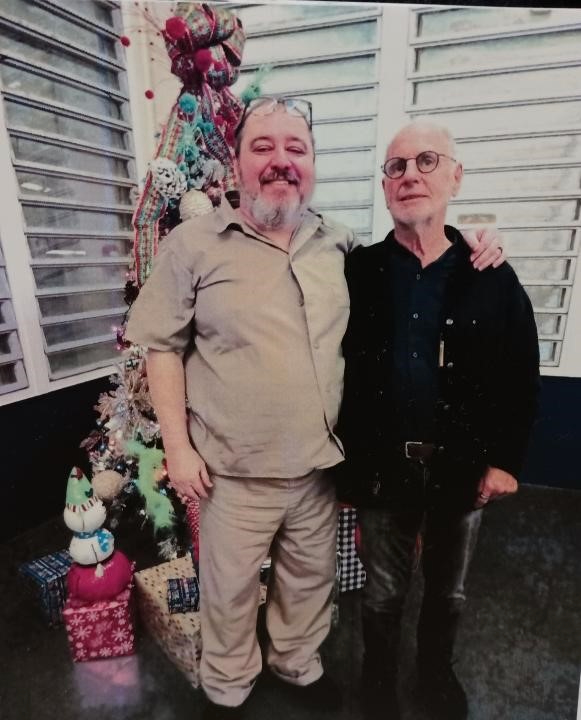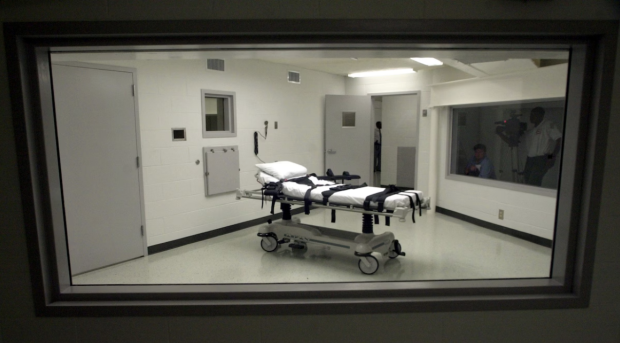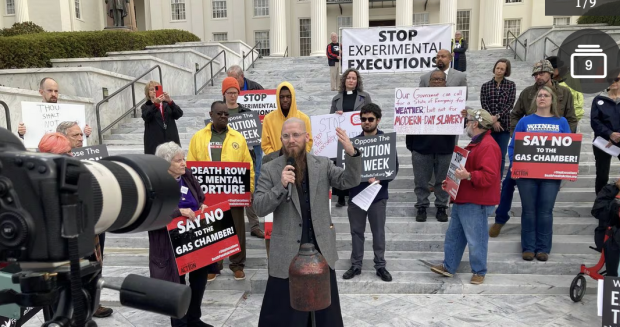January 25, 2024
Alabama plans first nitrogen execution on lethal injection survivor
Alabama plans first nitrogen execution on lethal injection survivor reports the Washington Post.
When Kenneth Eugene Smith enters the death chamber at the William C. Holman Correctional Facility in Atmore, Ala., on Thursday night, he will be in a place that is at once familiar and entirely unknown.
Smith, 58, is expected to be placed on the same gurney that was used 14 months earlier, when he survived a botched lethal injection that was eventually called off because his death warrant was expiring and prison workers failed to set his IV line. But instead of being administered lethal drugs, prison workers will place a mask over his face and start the process of making Smith the first person executed by an untested method that uses nitrogen gas to force death by oxygen depravation, a process known as nitrogen hypoxia.
If the execution moves forward, it will be the first time in more than 40 years that the United States has used a new execution method. The quest to use nitrogen hypoxia in executions came as drug companies refused to sell the chemical cocktails needed for lethal injections. It also encapsulates how proponents of capital punishment in America have been unrelenting in their fight to keep the practice alive. Twenty-one states still have the death penalty, and it remains legal but unused in six others because of suspension or moratorium.
Critics have decried nitrogen hypoxia, which is not known to be used for executions anywhere in the world, as human experimentation and akin to torture. The U.N. human rights office argued that the method could cause pain and suffering because Alabama does not intend to sedate Smith before execution. Alabama has argued it is a workable, effective method that will allow closure to the family of Smith’s victim from a 1988 murder-for-hire plot.
Smith is one of two living prisoners to survive an execution attempt. The trauma of his nearly four-hour failed lethal injection in November 2022 is part of the basis for his attorney’s legal arguments that subjecting Smith to execution again is cruel and unusual, and a violation of his rights.
Smith, in an interview with NPR in December, said after receiving his current execution date that his anxiety surged far past what he felt the last time.
“Everybody is telling me that I’m going to suffer,” he told NPR. “Well, I’m absolutely terrified.”

Kenneth Eugene Smith, left, and Philip Nitschke at the William C. Holman Correctional Facility in Atmore, Ala., on Dec 13.
Nitschke, a euthanasia advocate from Austria, served as an expert for Smith’s legal team. (Philip Nitschke)
The use of the death penalty in the United States has been on the decline for a decade. Changing attitudes toward capital punishment, difficulty in legally sourcing lethal injection drugs and wariness in the wake of botched executions have accelerated its disuse. Last year, just five states carried out executions, a figure the Death Penalty Information Center (DPIC), a nonprofit research organization, said is the lowest number of states in 20 years.
Alabama plans first nitrogen execution on lethal injection survivor
While some states have turned away from their death penalty process, others have sought to evolve theirs: switching the types of lethal injection drugs used, reviving once-abandoned methods such as the firing squad or developing new methods entirely.
New execution methods tend to emerge when people become uncomfortable with old ones, said Robin Maher, the executive director of the DPIC. The electric chair was created in the late 19th century and billed as more humane than hangings, but the gruesome spectacle of condemned men sizzling and sometimes catching fire in their wired chairs eventually fell out of favor, too.
“Executions moved indoors, into chambers, sometimes in the middle of the night,” Maher said. “They were made more clinical, more quiet, less bloody.”
Lethal injection fit that narrative, until drug manufacturers, starting with suppliers in the European Union, where capital punishment is banned, pulled their drugs from being used in executions. As states scrambled to find alternative drugs, they also increasingly enacted new statutes and constitutional amendments that shrouded their execution process in secrecy. States such as Oklahoma and Texas argued it was to prevent harassment of suppliers and interference with carrying out a legal punishment.
“Alabama has refused to tell the public critical information about its protocol,” Maher said.
Supreme Court refuses to stop Alabama nitrogen-gas execution
What is known about Alabama’s approach to Smith’s execution is drawn from a heavily redacted protocol released in court filings. Smith will be fitted with a mask, and pure nitrogen will flow into it until Smith no longer has oxygen left to breathe. The atmosphere is about 75 percent nitrogen, but breathing pure nitrogen with no oxygen in the mix is toxic and eventually leads to death.
Prison workers planned to meet several times before the execution to practice, and oxygen monitors will measure the air in the chamber. Unlike previous executions using cyanide gas, Smith will be on a gurney with nitrogen coming through his mask and not in an enclosed chamber.

Alabama’s lethal injection chamber at Holman Correctional Facility, seen in 2002. (Dave Martin/AP)
Alabama’s method “alarmed” Philip Nitschke, an Austrian [sic] doctor and euthanasia advocate who is familiar with using nitrogen gas in lethal situations through his work directing the pro-euthanasia group, Exit International.
Nitschke traveled to Alabama in December to look at the state’s setup for the nitrogen gas execution at the request of Smith’s lawyers. Seeing it in person did nothing to allay his anxiety, he told The Washington Post.
“This could be some grim and horrible, macabre death,” Nitschke said of Smith’s execution. He assessed that Alabama’s setup had the potential for significant error, including leaks in the mask, which could prolong the execution process.
Nitschke supports nitrogen hypoxia for assisted suicide but has rebuked Alabama’s approach. A key concern is the use of a face mask to deliver nitrogen gas, a method he said the “right to die” movement abandoned more than a decade ago in favor of pods, plastic bags or hoods that fully envelop the head.
Execution by gas has a brutal 100-year history. Now it’s back.
Nitrogen gas can yield a reliable, peaceful death, but there are glaring differences between the method used by people willfully wanting to kill themselves and what Alabama is attempting, Nitschke said. Patients who use nitrogen for assisted suicide are cooperative, calm and can practice entering a pod, or wearing a hood; Smith is being executed against his will.
Smith expressed fear in court filings that his mask could become dislodged if he prays out loud or hyperventilates. Nitschke inspected the mask Alabama plans to use and said it would be relatively easy to break the seal. At that point, the wearer could involuntarily gasp for enough oxygen to slow the process.
Anesthesiologist Joel Zivot, who teaches at Emory University and has performed numerous autopsies on executed prisoners, said states such as Alabama have a poor track record of carrying out constitutional executions. He notably performed the autopsy of Joe Nathan James Jr., where the state took about 3½ hours to complete his execution. Zivot was skeptical that a new method by the same state would fare any better than the three previous botched injections — including Smith’s in 2022 — that prompted Gov. Kay Ivey (R) to briefly suspend executions.
Jeff Hood, Smith’s spiritual adviser, had to sign a waiver acknowledging he could be exposed to the gas and had to agree to stand at least three feet from Smith, NPR reported.
“The most damming part of this to me is the idea of asking Jeff Hood to sign a waiver and saying ‘look, you could be at risk, too,’” Zivot said. “It’s such an obvious area of incompetence that they can’t even protect the witnesses.”
Hood told ABC affiliate WAAY in December that he feared for his safety.
“If a nitrogen leak were to happen in the execution chamber, who will be there?” said Hood. “What is the emergency procedure if I collapse?”

Protesters gather outside the Capitol in Montgomery, Ala., on Tuesday to call on Gov. Kay Ivey to stop the planned execution of Kenneth Eugene Smith. (Mickey Welsh/The Montgomery Advertiser/AP)
Alabama officials have steadfastly stood behind their procedure. In a filing to a federal appeals court last week, Attorney General Steve Marshall’s office called nitrogen hypoxia “the most painless and humane method of execution known to man.”
Marshall said carrying out Smith’s execution is important for holding Smith accountable for the 1988 murder-for-hire death of Elizabeth Sennett.
Sennett, a 45-year-old mother and pastor’s wife, was stabbed and beaten with a fireplace implement in what was staged to look like a home invasion and burglary at the Colbert County, Ala., house she shared with her husband, according to court records.
Investigators determined her husband, a preacher named Charles Sennett, who was having an affair and deeply in debt, had taken out an insurance policy on his wife and paid John Forrest Parker and Smith $1,000 each to kill his wife. Sennett killed himself a week after his wife’s murder when investigators identified him as a suspect. Parker was executed by lethal injection in 2010.
Mike Sennett, one of Elizabeth’s two sons, told WAAY that he plans to attend Smith’s execution with his brother, and that they have waited more years than the time they shared with their mother to see Smith executed.
“He’s got a debt to pay and it don’t matter to us how it happens,” he said.
Alabama plans first nitrogen execution on lethal injection survivor